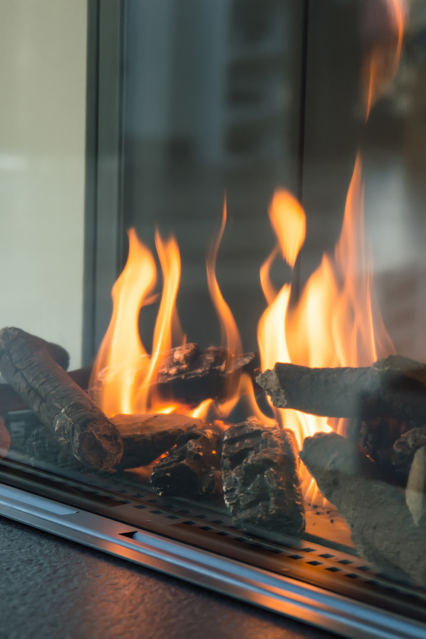Gas fireplaces are a great choice if you are looking for an efficient way to add warmth and ambiance to your living spaces, but safety should always be a top priority. Proper usage and maintenance of your gas fireplace are essential.
Always adhere to the manufacturer's instructions for
installing, operating, and maintaining your gas fireplace. The manual is a
comprehensive guide covering vital aspects such as installation, maintenance,
and operation. It outlines the correct procedures for lighting the fireplace,
adjusting the flames, and ensuring proper ventilation.
Overlooking these instructions can pose serious safety
risks, including gas leaks or improper combustion. By carefully following the
manual, you'll safeguard your home and loved ones and optimize the performance
and longevity of your gas fireplace.
In addition, there are other ways to ensure the safety of your gas fireplace. Let's highlight some essential tips for operating and maintaining your gas fireplace, ensuring you can enjoy it for years. Look for equipment that will last you a lifetime with proper care and view gas detection equipment here.
Gas Fireplace Safety
Regular Maintenance and Inspection
Regular inspections and maintenance are essential for the
safe operation of a gas fireplace. Over time, dust, debris, and soot buildup
can obstruct the vents and cause potential hazards. Don't take this on
yourself; hire a professional to inspect your fireplace annually. They will
check for leaks, clean the burners and vents, and ensure all components are in
working order.
A well-maintained gas fireplace operates
efficiently, which will reduce energy costs. Timely inspections will also help
identify issues early on, preventing costly repairs or replacements.
Install Carbon Monoxide Detectors
Gas fireplaces produce carbon monoxide (CO), a colourless
and odourless gas that can be harmful in high concentrations. Install carbon
monoxide detectors near the fireplace and regularly check their batteries to
ensure they function correctly. CO detectors act as an early warning system,
alerting you if dangerous levels of CO are present.
This is critical as CO exposure can lead to symptoms like
headaches, dizziness, and, in severe cases, even death. Having CO detectors
strategically placed creates a safer environment, giving you the peace of mind
to enjoy the warmth and comfort of your gas fireplace.
Use a Protective Screen or Barrier
The flames in a gas fireplace are created by burning
natural gas or propane, which are used as the fuel source. When the gas is
ignited, it produces a real, visible flame resembling a traditional
wood-burning fireplace.
Consider installing a protective screen or barrier in
front of your gas fireplace. This helps prevent accidental burns and keeps
children and pets safe from the flames and hot surfaces.
Keep the Area Clear
It's essential to have a clear space around the fireplace
to prevent potential hazards. Maintain a safe distance between your gas
fireplace and any flammable materials. This minimizes the risk of accidental
fires or overheating. Adequate clearance guarantees proper ventilation,
preventing the buildup of carbon monoxide.
Be cautious of flammable items near the fireplace, such
as curtains, furniture, or rugs, as even a minor ember could ignite a
fire.
Never Perform DIY Repairs
Avoid attempting repairs independently if you encounter
an issue with your gas fireplace. DIY repairs without proper expertise and
training can lead to accidents, gas leaks, or malfunctions, posing significant
risks to property and lives. Gas appliances should only be serviced and
repaired by qualified professionals. They have the knowledge and experience to
safely handle repairs, ensuring the fireplace operates correctly and
efficiently.
Related: Creating a Safe Home: Water Damage Tips
Turn Off the Gas Fireplace When Unattended
Always turn off the gas fireplace when leaving the room
or going to bed. Simply locate the control panel or knob on the fireplace and
turn it to the "off" position, shutting off the gas supply. This will
reduce the risk of an accident and ensure the unit is only used when
supervised.
It's also wise to double-check that the flame and pilot
light are entirely extinguished. Not only does this promote safety by reducing
fire risks, but it also helps save energy and reduce utility costs. Making it a
habit to turn off the gas fireplace when not needed contributes to a safer and
more efficient home.
Educate Family Members
Ensure everyone in your household, including children,
understands the safe operation and potential hazards associated with the gas
fireplace. Educate them on using it responsibly and what to do in an
emergency.
If old enough, teach them how to ignite and extinguish
the fireplace safely, including turning off the gas supply when not in use. Be
sure to reinforce the idea of adult supervision and keeping flammable items
away from the fireplace area.
By following the essential tips outlined here and always prioritizing safety, you can enjoy the warmth and comfort of your gas fireplace while minimizing risks. Remember to consult with a professional if you have any concerns or questions about the safe usage of your gas fireplace. Stay warm and stay safe! You might also want to seek experts, like fire protection LA, to help you install fire safety systems in case.



Post a Comment